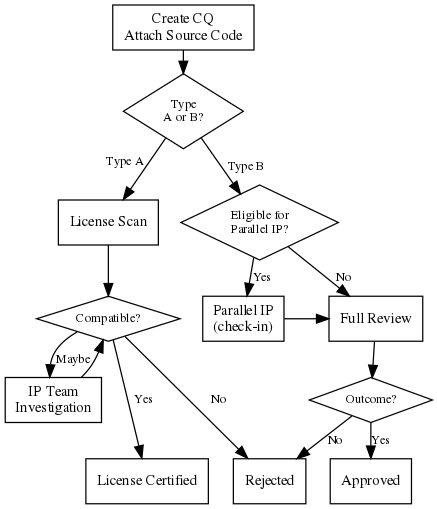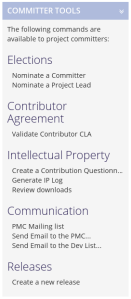All third party content must be taken through the Eclipse Foundation’s Intellectual Property (IP) Due Diligence Process before being used by an open source project hosted by the Eclipse Foundation. This includes all third party content that is incorporated into project code, included in builds, or otherwise required by the project code to provide functionality.
The Eclipse Foundation’s Guidelines for the Review of Third Party Dependencies defines various classifications of third party content and how project teams should engage in the IP process. The classification of third party content most commonly used is the so-called prerequisite dependency: a prerequisite dependency is third party content that the project either needs to distribute along with the project code, or otherwise have present in order to function.
Third party content is likely a prerequisite dependency if:
- project code accesses APIs;
- project code includes an import statement for a package from a library;
- project code uses reflection or other means to reference a library’s APIs and implementation;
- the Java/OSGi manifest for a project bundles makes a direct reference; or
- project code invokes a command line tool to access the functionality.
This list is not intended to be exhaustive, but rather to provide common examples. Fundamentally, if project code makes some kind of use of third-party content, then that content is likely a prerequisite. The guidelines provide for so-called works with and exempt prerequisite dependencies, but I’ll save that discussion for a future post.
Project committers can engage in the IP Due Diligence process by creating a contribution questionnaire (CQ) in the Eclipse Foundation’s IPZilla system.
The term contribution questionnaire is a bit misleading when it comes to third party content. Third party content is not a really a contribution to the project, but since the requirements for tracking project code and third party content is very similar, the same mechanism is used for both.
The workflow looks a little something like this:


Committer Tools
There’s an entry point that project committers can use to Create a Contribution Questionnaire in the Committer Tools block that is on every project’s information page (see the image on the right).
In the first step, the committer creates the CQ record with essential information about the third party content and then attaches the source code for that content (this currently happens in two separate steps). The corresponding Project Management Committee (PMC) must sign-off on the CQ before any further processing occurs.
As a general rule, a CQ should be created for each separate library. The process permits for some flexibility with regard to the definition of library. Content that has source in a single source repository that is distributed as multiple JAR files can very likely be regarded as a single library. There has also been cases where the IP Team has accepted a single CQ to do license certification for a collection of many different JavaScript sources. If you’re not sure, check with the IP Team.
License scanning software will be engaged for third party content that’s to be reviewed for license certification (type A). As we roll out this new type of IP due diligence, the IP Team is engaging the tool manually, evaluating the output, and making a determination. Our plan is to automate the invocation of the tool and make a determination automatically where possible (e.g. in cases where the licenses are clearly indicated in the content) and have the IP Team investigate further when necessary.
For requests to perform the more thorough IP due diligence process (type B), the workflow is different. For content that qualifies for parallel IP processing, the IP Team will do a cursory review and—assuming that the content passes muster—grant check in, meaning that the content can be pushed into the project’s source code repository and included in builds. The full due diligence review includes verification of the content’s provenance and a scan for all kinds of other anomalies (more on this in future posts). This process is a lot work that can take quite a lot of time to complete, and very often requires interaction with the committer. When the IP team completes a full review with a successful outcome, they’ll mark the CQ as approved.
All third party content must be either license certified or approved before an project can issue an official release. Any release that includes license certified content must be marked as a type A. A type A release may include type B content; A type B release, however, cannot include type A content.
I’ve thrown out a few concepts in this post without providing explanations. I’ll try and fill in the gaps in future posts, which will all be grouped in the intellectual property category.
